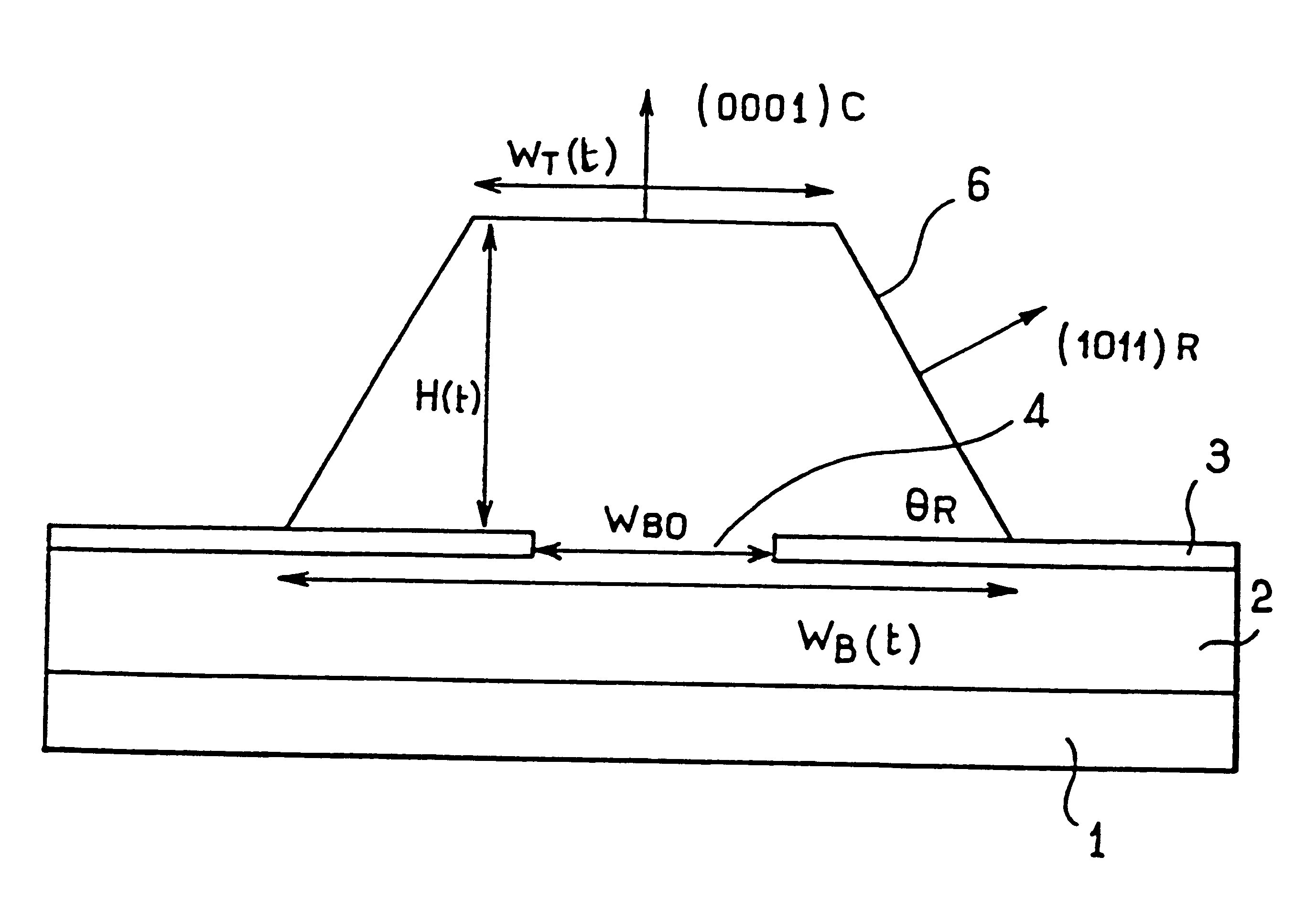Method for producing a gallium nitride epitaxial layer
a gallium nitride and epitaxial layer technology, applied in the direction of crystal growth process, crystal growth process, polycrystalline material growth, etc., can solve the problems of preventing the sapphire substrate from being removed, slowed down the development of diode lasers, and not being able to solve this problem, so as to achieve better gan crystal quality
- Summary
- Abstract
- Description
- Claims
- Application Information
AI Technical Summary
Benefits of technology
Problems solved by technology
Method used
Image
Examples
example 2
Deposition in the Gaseous Phase of a Layer of Gallium Nitride To Which Magnesium Has Been Added
The experiment of Example 1 is repeated apart from the fact that 2.8 .mu.mol / min. of (MeCp) .sub.2 Mg is introduced in the vapor phase. The conditions used are: growth time 30 min., growth temperature 1080.degree. C., TMGa 16 .mu.mol / min. and N.sub.2, H.sub.2 and NH.sub.3 2 sl / min. for each of them.
FIG. 6 shows that the presence of magnesium increases the V.sub.R / V.sub.C ratio well above the cos (.theta..sub.R) threshold and consequently the (0001) upper facet broadens. The selectivity of the growth is not affected by the presence of (MeCp).sub.2 Mg, but the growth anisotropy is advantageously modified.
example 3
Influence of the Mg / Ga Molar Ratio
FIG. 5 shows the variation in the growth rates normalized to the TMGA molar flux in the [0001] and [1011] directions as a function of the Mg / Ga molar ratio in the vapor phase.
In practice, it was chosen to keep a constant flux of (MeCp).sub.2 Mg and to vary the amount of TMGA. This makes it possible to ensure that the available Mg concentration on the surface of the growth islands is identical for all the specimens.
Because the growth is controlled linearly by the amount of gallium supplied, the growth rates are normalized in order to compare them.
V.sup.N.sub.C rapidly decreases from 0.8 to 0.1 .mu.m / h / .mu.mol, while V.sup.N.sub.R increases from 0.16 to 0.4 .mu.m / h / .mu.mol when the Mg / Ga molar ratio varies from 0 to 0.17. The dotted line is the curve of the V.sub.R / V.sub.C ratio obtained by extrapolation. The y-axis on the right is V.sub.R / V.sub.C .
This curve shows that the incorporation of Mg allows the pyramidal structure to be easily controlled b...
example 4
Two-step Deposition of a Gallium Nitride Layer
Firstly, the process according to the invention is carried out using epitaxial regrowth under operating conditions comparable to those of Example 1.
An SiN mask is deposited on a GaN layer deposited beforehand in an epitaxial manner in a suitable reactor on a crystallization substrate such as sapphire. Linear apertures 5 .mu.m in width and spaced apart by 5 .mu.m are then made in the mask in order to expose the regions of the subjacent layer. The linear apertures are advantageously oriented in the GaN [1010] direction, although the variant of the process described in this example can be optionally carried out for other orientations of the linear apertures, especially in the GaN [1120] direction.
The epitaxial regrowth is carried out on the exposed regions with unintentionally doped GaN under operating conditions such that the growth rate in the [0001] direction of the GaN features sufficiently exceeds the growth rate in the direction norma...
PUM
 Login to View More
Login to View More Abstract
Description
Claims
Application Information
 Login to View More
Login to View More - R&D
- Intellectual Property
- Life Sciences
- Materials
- Tech Scout
- Unparalleled Data Quality
- Higher Quality Content
- 60% Fewer Hallucinations
Browse by: Latest US Patents, China's latest patents, Technical Efficacy Thesaurus, Application Domain, Technology Topic, Popular Technical Reports.
© 2025 PatSnap. All rights reserved.Legal|Privacy policy|Modern Slavery Act Transparency Statement|Sitemap|About US| Contact US: help@patsnap.com

